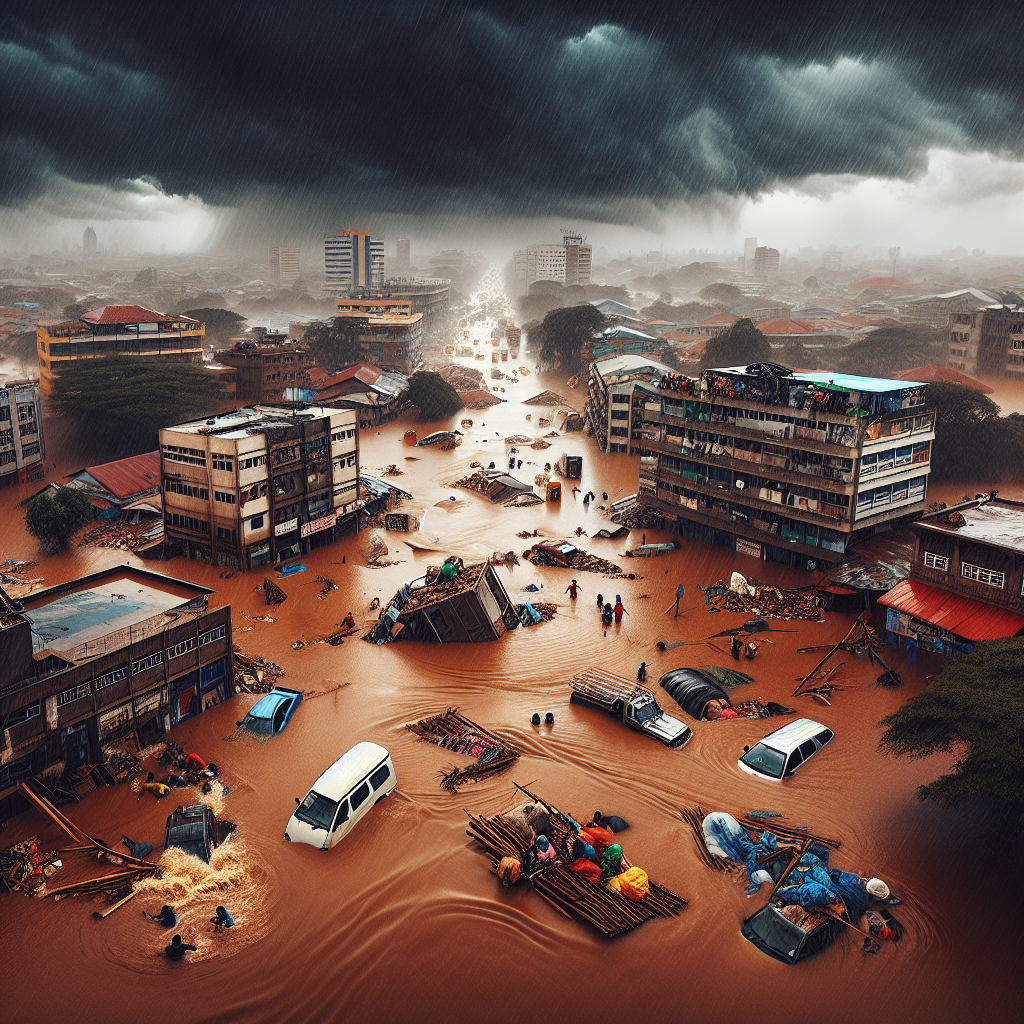-
Highlights
“Nairobi Floods: Unleashing Nature’s Wrath”
Introduction
Floods wreak havoc in Nairobi – Nature’s fury.
The Devastating Impact of Floods in Nairobi
Floods have wreaked havoc in Nairobi, leaving a trail of destruction and devastation in their wake. The city, known for its bustling streets and vibrant culture, has been brought to its knees by the fury of nature. The impact of these floods cannot be understated, as they have not only caused immense damage to infrastructure but have also claimed lives and disrupted the lives of countless individuals.
One of the most devastating consequences of the floods is the destruction of homes and buildings. Many residents have lost everything they own, as their houses have been completely submerged in water. The force of the floods has caused walls to crumble, roofs to collapse, and foundations to give way. The aftermath is a landscape of debris and ruin, leaving families homeless and without any means of shelter.
In addition to the destruction of homes, the floods have also caused significant damage to roads and bridges. The torrential rains have washed away layers of asphalt, leaving behind gaping potholes and unstable surfaces. This has not only made commuting a nightmare for residents but has also hindered emergency response efforts. Ambulances and fire trucks struggle to navigate the treacherous roads, delaying their arrival to those in need of urgent assistance.
Furthermore, the floods have disrupted the city’s infrastructure, causing power outages and water shortages. The electrical grid has been severely damaged, leaving many areas without electricity for days on end. This not only affects the daily lives of residents but also poses a threat to public safety. Without electricity, streetlights are non-functional, increasing the risk of accidents and crime during the night.
Moreover, the floods have claimed lives and caused injuries. The force of the water has swept away individuals, leaving families grieving for their loved ones. Those fortunate enough to survive often suffer from injuries sustained during the chaos. The loss of life and the physical and emotional trauma experienced by survivors cannot be quantified, further emphasizing the devastating impact of these floods.
It is clear that urgent action is needed to address the devastating impact of floods in Nairobi. The government must invest in infrastructure improvements, such as reinforcing buildings and constructing proper drainage systems. Additionally, emergency response teams should be equipped with the necessary resources to ensure a swift and effective response during times of crisis.
Furthermore, public awareness campaigns should be launched to educate residents on flood preparedness and safety measures. This includes teaching individuals how to evacuate safely, providing information on emergency shelters, and promoting the importance of having a disaster preparedness kit.
In conclusion, the floods in Nairobi have had a devastating impact on the city and its residents. The destruction of homes, damage to infrastructure, disruption of essential services, loss of life, and injuries suffered by survivors are all testament to the fury of nature. It is imperative that immediate action is taken to mitigate the effects of future floods and ensure the safety and well-being of the population. Only through proactive measures and a collective effort can Nairobi recover from this natural disaster and build a more resilient future.
Understanding the Causes and Consequences of Flooding in Nairobi

Floods wreak havoc in Nairobi – Nature’s fury
Understanding the Causes and Consequences of Flooding in Nairobi
Flooding is a natural disaster that has become all too common in Nairobi, the capital city of Kenya. The city, known for its vibrant culture and bustling economy, has been repeatedly hit by devastating floods, causing immense damage to infrastructure, homes, and livelihoods. It is crucial to understand the causes and consequences of these floods to effectively mitigate their impact and protect the city’s residents.
One of the primary causes of flooding in Nairobi is the city’s inadequate drainage system. As the city has rapidly expanded over the years, the drainage infrastructure has struggled to keep up with the increased demand. The existing drainage channels are often clogged with solid waste, leading to water accumulation during heavy rainfall. Additionally, the encroachment of buildings and settlements on natural waterways has further exacerbated the problem, restricting the flow of water and causing it to overflow onto the streets.
Another contributing factor to flooding in Nairobi is deforestation. The city’s once lush green areas have been gradually replaced by concrete structures, leaving little room for natural water absorption. Trees play a crucial role in regulating water flow by absorbing excess rainwater through their roots. With the loss of trees, rainwater runs off the impermeable surfaces, overwhelming the drainage system and causing floods. It is imperative to prioritize reforestation efforts to restore the city’s natural water retention capacity.
Climate change is also a significant factor in the increased frequency and intensity of floods in Nairobi. Rising global temperatures have led to more erratic weather patterns, including heavier rainfall events. The city’s infrastructure, designed to handle average rainfall, is ill-equipped to cope with these extreme weather events. As climate change continues to worsen, it is crucial to invest in climate-resilient infrastructure that can withstand the challenges posed by a changing climate.
The consequences of flooding in Nairobi are far-reaching and devastating. The immediate impact is the loss of lives and displacement of residents. Floodwaters can be powerful and destructive, sweeping away homes and infrastructure in their path. The destruction of homes leaves families homeless and vulnerable, often leading to a cycle of poverty and dependence on aid. Furthermore, floods contaminate water sources, increasing the risk of waterborne diseases such as cholera and typhoid, further endangering the health of the affected population.
Hotels in Nairobi where you can book tours by Cruzeiro Safaris Kenya
The economic consequences of flooding are also significant. Businesses are forced to shut down temporarily or permanently, leading to job losses and a decline in economic productivity. The cost of repairing damaged infrastructure and homes is substantial, diverting funds that could have been used for development projects. Additionally, the tourism industry, a vital source of revenue for Nairobi, suffers as potential visitors are deterred by the city’s flood-prone reputation.
To address the causes and consequences of flooding in Nairobi, a multi-faceted approach is required. Firstly, the city needs to invest in improving its drainage infrastructure, ensuring that it can handle the increased volume of water during heavy rainfall. Regular maintenance and clearing of drainage channels are essential to prevent blockages. Secondly, efforts should be made to restore green spaces and promote reforestation to enhance the city’s water absorption capacity. Lastly, Nairobi must prioritize climate change adaptation measures, including the construction of climate-resilient infrastructure and the development of early warning systems to alert residents of impending floods.
In conclusion, flooding in Nairobi is a pressing issue that requires urgent attention. By understanding the causes and consequences of these floods, we can develop effective strategies to mitigate their impact and protect the city’s residents. Improving the drainage system, promoting reforestation, and investing in climate-resilient infrastructure are crucial steps towards building a more resilient Nairobi that can withstand nature’s fury.
Mitigating Flood Risks in Nairobi: Strategies for a Resilient City
Floods wreak havoc in Nairobi – Nature’s fury
Nairobi, the capital city of Kenya, has been grappling with the devastating effects of floods for years. The heavy rains that hit the city during the rainy season often lead to overflowing rivers and flash floods, causing immense damage to infrastructure, homes, and even loss of lives. The recent floods in Nairobi have once again highlighted the urgent need for effective strategies to mitigate flood risks and build a resilient city.
One of the key strategies to mitigate flood risks in Nairobi is the improvement of drainage systems. The existing drainage infrastructure in the city is outdated and inadequate to handle the increasing volume of water during heavy rains. As a result, water accumulates on the streets, causing traffic congestion and posing a significant risk to pedestrians and motorists. By investing in the expansion and modernization of the drainage systems, the city can ensure that excess water is efficiently channeled away, reducing the risk of flooding.
https://cruzeiro-safaris.com/nairobi-tours/location/kenya-national-parks/
Another crucial aspect of flood risk mitigation is the preservation and restoration of natural water bodies and wetlands. Nairobi is blessed with several rivers and wetlands that play a vital role in regulating water flow and preventing floods. However, due to rapid urbanization and encroachment, many of these natural water bodies have been destroyed or polluted. By protecting and restoring these ecosystems, the city can enhance its resilience to floods and ensure a sustainable water management system.
In addition to infrastructure improvements and ecosystem preservation, community engagement and awareness are essential in mitigating flood risks. The residents of Nairobi need to be educated about the causes and consequences of floods, as well as the measures they can take to protect themselves and their properties. This can be achieved through public awareness campaigns, workshops, and training programs that empower individuals and communities to become active participants in flood risk reduction.
Furthermore, urban planning and land use management play a crucial role in flood risk mitigation. Unplanned and haphazard development exacerbates the vulnerability of the city to floods. By implementing strict regulations and guidelines for construction in flood-prone areas, the city can prevent further encroachment on floodplains and ensure that new developments are resilient to flooding. Additionally, the incorporation of green infrastructure, such as rain gardens and permeable pavements, can help absorb excess water and reduce the risk of floods.
Lastly, effective flood forecasting and early warning systems are vital in mitigating flood risks. By investing in advanced technology and data collection, the city can accurately predict and monitor rainfall patterns, river levels, and potential flood zones. This information can then be disseminated to the public through various communication channels, enabling individuals and communities to take timely action and evacuate if necessary.
8-Day Wildness and Nature Safari in Kenya with Cruzeiro Safaris
In conclusion, the recent floods in Nairobi have once again highlighted the urgent need for strategies to mitigate flood risks and build a resilient city. By improving drainage systems, preserving natural water bodies, engaging communities, implementing effective urban planning, and investing in flood forecasting, Nairobi can reduce the devastating impacts of floods and ensure the safety and well-being of its residents. It is crucial for the city authorities, stakeholders, and the community to come together and take proactive measures to protect Nairobi from nature’s fury.
Conclusion
In conclusion, floods wreak havoc in Nairobi, causing significant damage and destruction. The force of nature’s fury during these floods can have devastating consequences for the city and its residents.
Click here to learn more about the devastating floods wreaking havoc in Nairobi and discover how you can help: https://cruzeiro-safaris.com/nairobi-tours/
